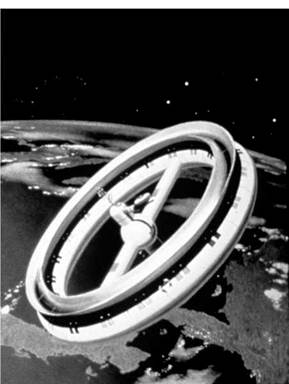1946—THE VON BRAUN STATION—WERNHER VON BRAUN
In a 1946 summary of his work during World War II, Wernher von Braun prophesied the construction of space stations in orbit. The design, which owed a great deal to the earlier work of Noordung, consisted of a toroidal station spun to provide artificial gravity. Von Braun elaborated on this initial design at the First Symposium on Space Flight on 12 October 1951 hosted by the Hayden Planetarium in New York City. The design was popularised in 1953 in a series in Colliers magazine, illustrated with a gorgeous painting by Chesley Bonestell.
1948—THE BRITISH INTERPLANETARY SOCIETY STATION—H. E. ROSS
In a paper presented to the British Interplanetary Society (BIS), and reprinted in the Journal of the BIS in 1949, H. E. Ross described a manned satellite station in Earth orbit that would serve as an astronomical, zero-gravity, and vacuum research laboratory, and also serve as a way-station for the exploration of the moon. His suggested design comprised a circular structure that housed the crew of the space laboratory
|
The 1946 von Braun Station |
(numbering 24 specialists and support personnel) as well as telescopes and research equipment. The station, he suggested, could be resupplied with oxygen and other life – support essentials by supply ships launched every three months.











